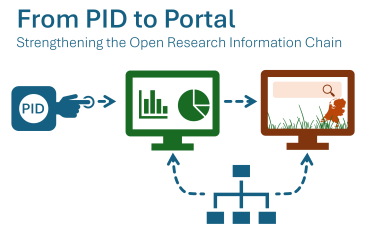Introduction
Open Science is gradually becoming the modus operandi in research practices, affecting the way researchers collaborate and publish, discover, and access scientific knowledge. Scientists are increasingly publishing research results beyond the article, to share all scientific products (metadata and files) generated during an experiment, such as research data, research software, experiments. They publish in scholarly communication data sources (e.g. institutional repositories, data archives, research software repositories), rely where possible on persistent identifiers (e.g. DOI, ORCID, Grid.ac, PDBs), specify semantic links to other research products (e.g. supplementedBy, citedBy, versionOf), and possibly to projects and/or relative funders. By following such practices, scientists are implicitly constructing the Global Open Science Graph, where by "graph" we mean a collection of objects interlinked by semantic relationships.
The OpenAIRE Graph includes metadata and links between scientific products (e.g. literature, research data, research software, and "other research products"), organizations, funders, funding streams, projects, communities, and (provenance) data sources - the details of the graph data model can be found in Zenodo.org.
The Graph is available and obtained as an aggregation of the metadata and links collected from ~90.000 trusted sources, further enriched with metadata and links provided by:
-
OpenAIRE end-users, e.g. researchers, project administrators, data curators providing links from scientific products to projects, funders, communities, or other products;
-
OpenAIRE Full-text mining algorithms over around ~15Mi Open Access article full-texts;
-
Research infrastructure scholarly services, bridged to the graph via OpenAIRE, exposing metadata of products such as research workflows, experiments, research objects, research software, etc.
Open and transparent
It is available for download and re-use as CC-BY (due to some input sources whose license is CC-BY); parts of the graphs can be re-used as CC-0; provenance is tracked at the level of the records and, when these are the result of full-text mining, of the properties (provenance also includes an indicator of trust, in the range [0..1]).
Intelligent linking
Abstracts, full-texts of Open Access publications and links are processed by several algorithms that infer new links and enrich the graph.
Decentralized and interoperable
Metadata and links are collected from data sources, such as institutional/data/software repositories, publishers, registries, and re-distributed to such sources via brokering services.
Embedded metrics
Powers up calculation of advanced statistics and metrics about Open Science and research impact.
Infrastructure
The OpenAIRE Graph is operated and maintained at the ICM cutting-edge Technology centre with the facilities and staff guaranteeing robust operation of the whole system. Okeanos SuperComputer hosting the graph consists of 26016 cores in total providing 1082 Tflops/s.
For more....
For more information about the Graph (documentation, access to the data, collaborations, scientific publications), please visit http://graph.openaire.eu



0 Praat mee